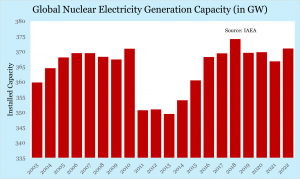ForumIAS announcing GS Foundation Program for UPSC CSE 2025-26 from 19 April. Click Here for more information.
Source-This post on Nuclear energy- A solution for clean energy transition has been created based on the article “Explained: The push for nuclear energy as climate solution” published in “The Indian Express” on 1 April 2024.
UPSC Syllabus-GS Paper-3– Infrastructure: Energy, Ports, Roads, Airports, Railways etc.
News– Brussels has recently hosted a first-of-its-kind Nuclear Energy Summit. It was touted as one of the most high-profile international meetings on nuclear energy ever.
Context– This meeting is one of the latest in a series of efforts that were being made in the last few years to project nuclear energy as an important solution to deal with problems of climate change and energy security.
What is Indias position on nuclear energy?
1) India has 23 operational nuclear reactors. The currently operational reactors have a combined installed electricity generating capacity of 7,480 MW (about 7.5 GW). The share of nuclear energy in total electricity generation capacity is just about 3.1%. This is among the lowest in countries that do use nuclear energy
2) There are at least ten more reactors that are under construction, and the capacity is supposed to triple to 22,480 MW by 2031-32.
India does acknowledge the role of nuclear energy in its decarbonization plan and is planning for a rapid expansion in the coming years. However, despite this also, the share of nuclear energy in electricity generation is likely to remain extremely modest in the future.
What is the status of nuclear energy installation in the world?
1) As per IAEA data, the number of operational nuclear reactors has come down in the last 20 years, from 437 in 2003 to 411. The average life of these reactors is more than 31 years, which also highlights the fact that few new reactors have been installed in the last decade.
2) The total installed electricity generation capacity has shown only a marginal increase during this period, from about 360 GW in 2003 to 371 GW now.
3) It accounts for less than 10 % of global commercial electricity generation. Its share has been declining for almost three decades now.
What is the significance of nuclear energy in meeting the twin objective of energy security and decarbonization?
1) Reduced carbon emission-It is a clean source of energy with a minimal carbon footprint. As per IAEA, (International Atomic Energy Agency) even when the entire life cycle is considered such as reactor construction, uranium mining and enrichment, waste disposal and storage etc, greenhouse gas emissions are only in the range of 5 to 6 grams per kilowatt hour.
This is more than 100 times lower than coal-fired electricity, and about half the average of solar and wind generation.
2) Incessant Supply-It provides continuous power, unlike wind or solar which are seasonal or time-dependent.
3) Endorsed by IPCC & others– Adoption of nuclear energy is recommended by IPCC(Intergovernmental Panel on Climate Change) for decarbonization. As IAEA, it is already contributing to reducing greenhouse gas emissions. Nuclear power generation results in avoiding emissions of more than 1 billion tonnes of CO2 equivalent every year.
What are the reasons for low installation of nuclear energy in the world?
1) Safety concerns– This is one of the main reasons behind the poor uptake of nuclear energy in recent years. For ex- Fukushima accident in 2011 and the continuing crisis at the Zaporizhzhya nuclear power plant in Ukraine.
2) High cost– Nuclear reactors require high investments and a technology base.They take years to build and must operate under a variety of regulations and constraints which makes them unattractive for many small and developing countries.
3) Lack of research-There has been lack of research to bring down the cost of nuclear energy like solar and wind in the last decade. As a result, rapid adoption of nuclear energy could not occur.
Read more- India’s Nuclear Energy Program
What are the steps taken to promote nuclear energy in the world?
1) Initiatives by IAEA-
a) It has also organized the first-of-its-kind Nuclear Energy Summit in Brussels recently.
b) It has launched an ‘Atoms4Climate’ initiative to highlight the potential of nuclear power to accelerate the clean energy transition.
C) It has set up a pavilion for the first time at COP27 in Sharm el-Sheikh.
2) COP Outreach-Outcome from COP 28 formally acknowledged that nuclear energy is one of the zero, or low-emission technologies that should be promoted to achieve rapid decarbonization. This was the first time that nuclear energy was mentioned in any COP outcome.
There is this misperception that renewables will solve everything in the short run. However, in the long run, as the demand for clean energy increases, there will be requirement of nuclear energy in a big way.
Question for practice
What are the reasons for low installation of nuclear energy in the world? What steps have been taken by IAEA recently to address this?






